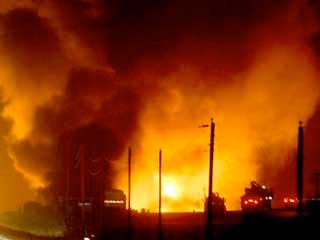The way natural gas promoters talk about their pet fuel, you’d think it was green as clover and safe as baby oil. After the deadly San Bruno, California, gas line explosion, however, hawkers like natural gas billionaire T. Boone Pickens have gone silent. No more calls to action and pleas to phone your member of Congress to demand bigger subsidies.
The quiet is welcome. Let’s use that space to talk about all of the drawbacks. We know how explosive plain old natural gas is (the photo here is of a 2007 blast–they’re not so rare), and we know that we have no idea where those big, aging pipelines are. National security and all that.
But it doesn’t stop there. The current rage in natural gas extraction is deep-drilling in shale formations, mostly in the Northeast and the West. Its dangers have been soberly reported, mostly by the online investigative website ProPublica. But even reports of flammable gas instead of water coming out of kitchen faucets in drilling areas doesn’t fire the imagination like 100-foot flames and victims so incinerated they can’t be found.
The deep drilling, called “fracking,” puts drinking water supplies at risk. It trashes the landscape, and uses vast amounts of fresh water, most of which cannot be reclaimed, to force the gas upward.
If, as Mr. Pickens hopes, Americans will take to automobiles powered by heavily subsidized natural gas, your local “gas” station would be a big potential neighborhood bomb. Some of that natural gas would have to be imported (yep, just like oil), in the form of heavily compressed liquefied natural gas, stored in gigantic tanks near shore or onshore until it’s warmed up and sent through a pipeline.






